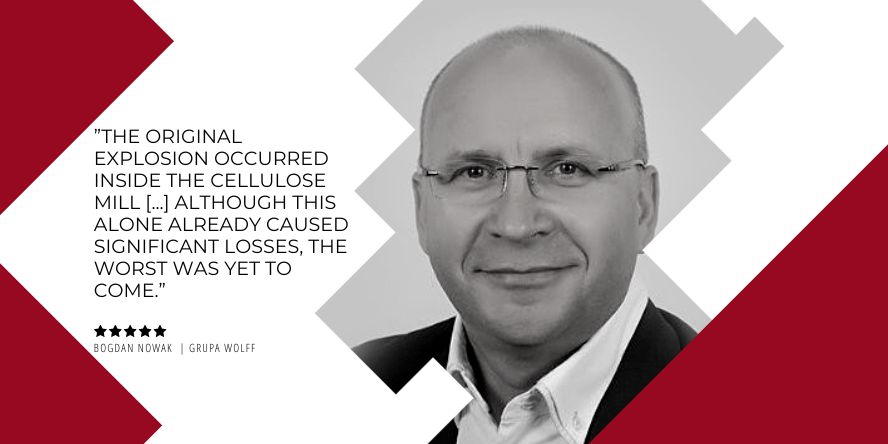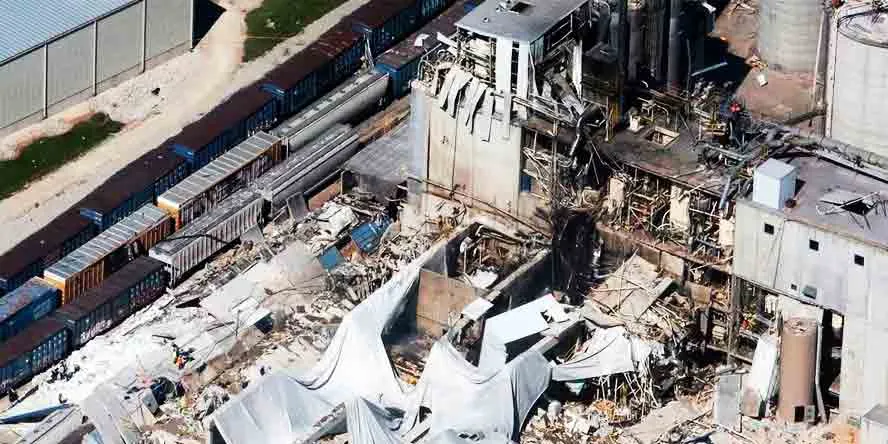Problem
- an explosion at one of the investor’s plants destroyed a large part of the production hall
- it was necessary to identify the causes, implement procedures and safeguards to protect this site and other sites of the company against similar incidents
- the changes made were the key to obtaining an insurance policy
Solution
- we have prepared an Explosion Prevention Document (EPD)
- we agreed upon the recommendations of the EPD with the investor and the insurer and implemented them
- we have protected the grinding and dust removing installation against explosion
- we have protected 11 dust extraction ducts with a spark detection and extinguishing system
- we have implemented a central vacuum cleaning system to eliminate the deposited dust
The explosion that changed everything
In this particular case, our work began, or rather accelerated, after an explosion occurred at one of the sites of the company, for which we carried out this task. The accident was triggered at a cellulose mill providing cellulose used as dietary fibre. Unfortunately, the lack of proper installation protection meant that the explosion, the consequences of which could have been quickly contained, escalated to enormous proportions.
Bogdan Nowak – the man who was involved in securing the rebuilt plant – describes the incident as follows: the original explosion occurred inside the cellulose mill. The pressure and flames propagated inside the installation, damaging downstream equipment of the process line. Although this alone already caused significant losses, the worst was yet to come. The consequences of the explosion quickly escaped the installation and propagated into the hall. The fibre deposited on the floor and on the equipment was lifted into the air. The dust cloud ignited, which resulted in secondary explosions. The hall and some of the equipment were severely damaged. What was not damaged by the explosion, was largely destroyed by the subsequent fire.

Following these incidents, the management of the company decided to implement changes that are intended to protect all the sites of the company and their staff from similar incidents in the future. Our task was to carry out an assessment of the current situation, implement procedures and design and implement safeguards.
Generally speaking, our scope of work included:
- preparation of an Explosion Prevention Document, including recommendations
- identification of procedures necessary to improve the security level
- protection of 11 dust removal lines using a spark detection and extinguishing system
- protection of mills and dust collectors against the effects of an explosion using explosion suppression and isolation
- implementation of a central vacuum cleaning system
The scope of work was agreed upon with the investor and approved by the insurer, wherein said approval was necessary to obtain an insurance policy.
EPD for the starters
We started the work with preparing an Explosion Protection Document. At this stage, we have assessed the risk generated by individual nodes within the installations. We then developed recommendations in consultation with the investor and the insurer, which we have systematically implemented. The changes at the site included the implementation of procedures, which are the cheapest and the most effective preventive measures, as well as the use of specific explosion protection measures.
The mill as a source of ignition
Continuing, Nowak indicated the probable cause of the explosion inside the mill: there are few pieces of equipment with such a high ignition risk in the industry as impact mills. Foreign bodies entering the milling chamber together with the fed material are a huge problem here. A screw, a nut or a nail can cause sparks or friction, generating temperatures of up to several hundred degrees Celsius. It was a foreign body that was the likely cause of the ignition and explosion at the fibre mill.

However, the mill does not need a foreign body to reach hazardous temperatures. All it takes is for the milling chamber to become clogged or for larger, not yet ground particles to become wedged between the rotor and stator, to cause a drastic increase in temperature.
It is true that the described phenomena can ignite dust and cause an explosion in the mill itself – such as in the described case – but this is not the only possible scenario. It is also very likely that glowing particles may be drawn from the mill into the dust removal system, which could also result in an explosion. We are going to expound upon this thread in the latter part of the article, however. Now, we are going to focus on the explosion risk in mills.
Explosion protection for mills
To say that impact mills can have various designs is as good as saying nothing at all. Thus, three mill types were used at the discussed site alone, some of which also included custom modifications made during the last few years of their operation. This required us to take an individual approach to securing each of the devices, – kontynuuje Nowak.
Without going into detail, our aim was to minimise the explosion pressure inside the mill and to isolate it from the rest of the installation, such that the explosion would not spread to neighbouring equipment.
The openings providing air intake to the mills should also be routed outside the hall via ducts. This part was extremely important, as it was such an unprotected opening which caused the explosion to propagate from the mill to inside the hall, dramatically increasing the losses.
This approach was dictated by legal requirements, an analysis of the described incident, as well as our experience gained at similar sites. The conclusions of the analysis, together with the preventive steps taken, are presented in the table below.
Explosion protection of dust removal installations
The performed Explosion Risk Assessment showed a high risk of explosion in the dust collectors. Explosive atmosphere, as well as a turbulent motion of air and dust are always present inside those units. The very low cellulose ignition energy additionally increasing the risk of explosion was also extremely important. This, combined with the identified ignition sources, necessitated specific measures intended to minimise the risk of explosion and its consequences, which we have described in the table below.
Two types of protection used to protect dust collectors
Dust collector protected by a decompression panel
Upon the explosion, the panel bursts in a controlled manner, releasing excessive pressure and flames from inside the protected device to the surroundings. NOTE: the decompression panels are a very effective solution, however, it has a number of limitations. Their misuse can pose hazards.
A dust collector protected using explosion suppression
The explosion is detected within a few tens of milliseconds and then suppressed by releasing special powder into the protected device. Contrary to decompression panels, explosion suppression prevents a fire inside the device after an explosion and may be used inside enclosed spaces and with hazardous substances.
What is easier to ignite – dust or a branch?
Products in the dust form have a much higher propensity to ignite and explode than the same substances before grinding. Wood, bamboo or oats, from which dietary fibre is produced, are relatively inflammable. Their ignition on a hot surface or from sparks would be extremely difficult. However, their tendency to ignite increases drastically once ground to a fine powder. This is quite intuitive – look at lighting a campfire, which is started using small twigs, as these are much easier to set alight than thick branches. Exactly the same principle works here – the finer the material, the easier it is to ignite.
A mill working like a dryer
It is believed that wet product at the process entry point results in a low explosion risk. Are you sure?
Fakt ten wyjaśnia Bogdan Nowak z GRUPY WOLFF: wspomniałem już, że młyny udarowe w czasie normalnej pracy generują ciepło. Dodajmy do tego także fakt, że ich prawidłowe działanie wymaga ciągłego dolotu powietrza. Rezultat? Młyn pracuje podobnie jak suszarka pozbawiając pył wilgoci. To z kolei drastycznie zwiększa jego tendencję do zapłonu. Zawsze należy o tym pamiętać.
Am I also at the risk of explosion?
If you are wondering if dust explosion risk is present at your site, it is likely worthy to have a casual talk without our experts. In many cases, we are able to indicate that such risk is absent at the given site during a quick telephone call. In other cases, I recommend carrying out an ATEX Audit – the cheapest and fastest method assessing whether a dust explosion risk is present at your workplace.





